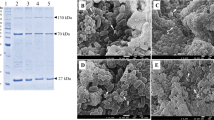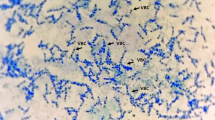Summary
The crystalline parasporal inclusions (crystals) of Bacillus thuringiensis israelensis (Bti), which are specifically toxic to mosquito and black fly larvae, contain three main polypeptides of 28 kDa, 68 kDa and 130 kDa. The genes encoding the 28 kDa protein and the 130 kDa protein have been cloned from a large plasmid of Bti. Escherichiacoli recombinant clones containing the 130 kDa protein gene were highly active against larvae of Aedes aegypti and Culex pipiens, while B. subtilis recombinant cells containing the 28 kDa protein gene were haemolytic for sheep red blood cells. A fragment of the Bti plasmid which is partially homologous to the 130 kDa protein gene was also isolated; it probably corresponds to part of a second type of mosquitocidal toxin gene. Furthermore, restriction enzyme analysis suggested that the 130 kDa protein gene is located on the same Bti EcoRI fragment as another kind of Bti mosquitocidal protein gene cloned by Thorne et al. (1986). Hybridization experiments conducted with the 28 kDa protein gene and the 230 kDa protein gene showed that these two Bti genes are probably present in the plasmid DNA of B. thuringiensis subsp. morrisoni (PG14), which is also highly active against mosquito larvae.
Similar content being viewed by others
References
Amstrong JL, Rohrmann GF, Beaudreau GS (1985) Delta endotoxin of Bacillus thuringiensis subsp israelensis. J Bacteriol 161:39–46
Anagnostopoulos C, Spizizen J (1961) Requirements for transformation in Bacillus subtilis. J Bacteriol 81:741–746
Birnboim HC, Doly J (1979) A rapid alkaline extraction procedure for screening recombinant plasmid DNA. Nucleic Acid Res 7:1513–1523
Dulmage HT (1981) Insecticidal activity of isolates of Bacillus thuringiensis and their potential for pest control. In: Burges HD (ed), Microbial Control of Pests and Plant Diseases. Academic Press, London, pp 193–223
Ellar DJ, Thomas WE, Knowles BH, Ward S, Todd J, Drobniewski F Lewis J, Sawyer T, Last D, Nichols C (1985) Biochemistry, Genetics and Mode of Action of B. thuringiensis δ-Endotoxins. In: Hoch JA, Setlow P (eds), Molecular Biology of Microbial Differentiation, American Society for Microbiology, Washington, DC pp 230–240
Goldberg LH, Margalit J (1977) A bacterial spore demonstrating rapid larvicidal activity against Anopheles sergentii, Uranotaenia unguiculata, Culex univitatus, Aedes aegypti and Culex pipiens. Mosq News 37:355–358
Gonzalez JM, Carlton BC (1984) A large transmissible plasmid is required for crystal toxin production in Bacillus thuringiensis var. israelensis. Plasmid 11:28–38
Guillet P, Escaffre H, Prud'hom JM (1982) Bacillus thuringiensis H14, a biocontrol agent for onchocerciasis control in West Africa. Proc 3rd Int Colloq Invert Pathol Brighton 1982, pp 460–465
Grunstein M, Hogness D (1975) Colony hybridization: a method for the isolation of cloned DNAs that contain a specific gene. Proc Natl Acad Sci USA 72:3961
Helfman DM, Feramisco JR, Fiddes JC, Thomas GT, Hughes SH (1983) Identification of clones that encode chicken tropomyosin by direct immunological screening of a cDNA expression library. Proc Natl Acad Sci USA 80:31–35
Holmes DS, Quigley M (1981) A rapid boiling method for the preparation of bacterial plasmids. Anal Biochem 114:193–197
Howe CJ, Bowman CM, Dyer TA, Cray JC (1982) Localization of wheat chloroplast genes for the beta and epsilon subunits of ATP synthase. Mol Gen Genet 186:525–530
Huber HE, Luthy P, Ebersoid HR, Cordier JL (1981) The subunits of the parasporal crystal of Bacillus thuringiensis size, linkage and toxicity. Ach Microbiol 129:14–18
Hurley JM, Lee SG, Andrews Jr J, Klowden MJ, Bulla Jr LA (1985) Separation of the cytolytic and mosquitocidal proteins of Bacillus thuringiensis subsp. israelensis. Biochem Biophys Res Commun 126:961–965
Ibarra JE, Federici BA (1986) Parasporal bodies of Bacillus thuringiensis subsp. morrisoni (PG-14) and Bacillus thuringiensis subsp, israelensis are similar in protein composition and toxicity. FEMS Microbiol Lett 34:79–84
Kim KH, Ohba M, Aizawa K (1984) Purification of the toxic protein from B. thuringiensis serotype 10 isolate demonstrating a preferential larvicidal activity to mosquito. J Invert Pathol 44:214–219
Klier A, Lereclus D, Ribier J, Bourgouin C Menou G, Lecadet MM and Rapoport G (1985) Cloning and expression in Escherichia coli of the crystal protein gene from Bacillus thuringiensis strain aizawa 7–29 and comparison of the structural organization of genes from different serotypes. In: Hoch JA, Setlow P (eds), Molecular biology of microbial differentiation American society for Microbiology, Washington, DC pp 217–224
Kronstad JW, Schnepf HE, Whiteley HR (1983) Diversity of locations of Bacillus thuringiensis crystal protein genes. J Bacteriol 154:419–428
Larget I, de Barjac H (1981) Spécificité et principe actif de Bacillus thuringiensis var israelensis. Bull Soc Path Ex 74:216–227
Lee SG, Eckblad W, Bulla Jr LA (1985) Diversity of protein inclusion bodies and identification of mosquitocidal protein in Bacillus thuringiensis subsp. israelensis. Biochem Biophys Res Commun 126:953–960
Maniatis T, Fritsch EF, Sambrook J (1982) Molecular coloning. A laboratory manual. Cold Spring Harbor Laboratory, Cold Spring Harbor, NY
O'Farrell PH (1975) High resolution two dimensional electrophoresis of proteins. J Biol Chem 250:4001–4007
Padua LE, Ohba M, Aizawa K (1980) The isolates of Bacillus thuringiensis serotypes 10 with a highly preferential toxicity to mosquito larvae. J Invert Pathol 36:180–186
Padua LE, Ohba M, Aizawa K (1984) Isolation of a Bacillus thuringiensis strain (serotype 8a:8b) highly and selectively toxic against mosquito larvae. J Inverst Pathol 44:12–17
Rigby DWJ, Dieckman M, Rhodes C, Berg P (1977) Labelling deoxyribonucleic acid to high specific activity in vitro by nick translation with DNA polymerase I. J Mol Biol 113:237–251
Schnell DJ, Pfannenstiel MA, Nickerson KW (1984) Bioassay of solubilized Bacillus thuringiensis var. israelensis crystals by attachment to latex beads. Science 223:1191–1193
Schnepf HE, Wong HC, Whiteley HR (1985) The amino acid sequence of a crystal protein from Bacillus thuringiensis deduced from the DNA base sequence. J Biol Chem 260:6264–6272
Sekar V, Carlton BC (1985) Molecular cloning of the delta-endotoxin gene of Bacillus thuringiensis va israelensis. Gene 33:151–158
Southern EM (1975) Detection of specific sequences among DNA fragments separated by gel electrophoresis. J Mol Biol 98:503–517
Thomas WE, Ellar DJ (1983) Bacillus thuringiensis var. israelensis crystal δ-endotoxin: effects on insect and mammalian cells in vitro and in vivo. J Cell Sci 60:181–197
Thorne L, Garduno F, Thomson T, Decker D, Zounes M, Wild M, Walfield AM, Pollock TJ (1986) Structural similarity between the Lepidoptera-and Diptera-specific insecticidal endotoxin genes of Bacillus thuringiensis subsp. “kurstaki” and “israelensis”. J Bacteriol 166:801–811
Visser B, Van Workum M, Dullemans A, Waalwijk C (1986) The mosquitocidal activity of Bacillus thuringiensis var. israelensis is associated with Mr. 230,000 and 130,000 crystal proteins. FEMS Microbiol Lett 30:211–214
Walwijk C, Dullemans AM, Van Workum MES, Visser B (1985) Molecular cloning and the nucleotide sequence of the Mr 28,000 crystal protein gene of Bacillus thuringiensis subsp. israelensis. Nucleic Acids Res 13:8207–8217
Ward ES, Ellar DJ, Todd JA (1984) Cloning and expression in Escherichia coli of the insecticidal δ-endotoxin gene of Bacillus thuringiensis israelensis FEBS Lett 175:377–382
Whiteley HR, Schnepf HE, Kronstad JW, Wong HC (1984) Structural and regulatory analysis of a cloned Bacillus thuringiensis crystal protein gene. In: Ganesan AT, Hoch JA (eds), Genetics and Biotechnology of Bacilli, Academic Press, New York, pp 375–386
Whiteley HR, Kronstad JW, Schnepf HE (1985) Structure and expression of cloned Bacillus thuringiensis toxin genes. In: Hoch JA, Setlow P (eds) Molecular Biology of Microbial Differentiation. American Society for Microbiology, Washington, DC pp 225–229
Wong HC, Chang S (1986) Identification of a positive retroregulator that stabilizes mRNAs in bacteria. Proc Natl Acad Sci USA 83:3233–3237
Yamamoto T, Iizuka T, Aronson JN (1983) Mosquitocidal protein of Bacillus thuringiensis susp. israelensis: identification and partial isolation of the protein. Curr Microbiol 9:279–284
Author information
Authors and Affiliations
Additional information
Communicated by A. Böck
Rights and permissions
About this article
Cite this article
Bourgouin, C., Klier, A. & Rapoport, G. Characterization of the genes encoding the haemolytic toxin and the mosquitocidal delta-endotoxin of Bacillus thuringiensis israelensis . Mol Gen Genet 205, 390–397 (1986). https://doi.org/10.1007/BF00338072
Received:
Issue Date:
DOI: https://doi.org/10.1007/BF00338072




